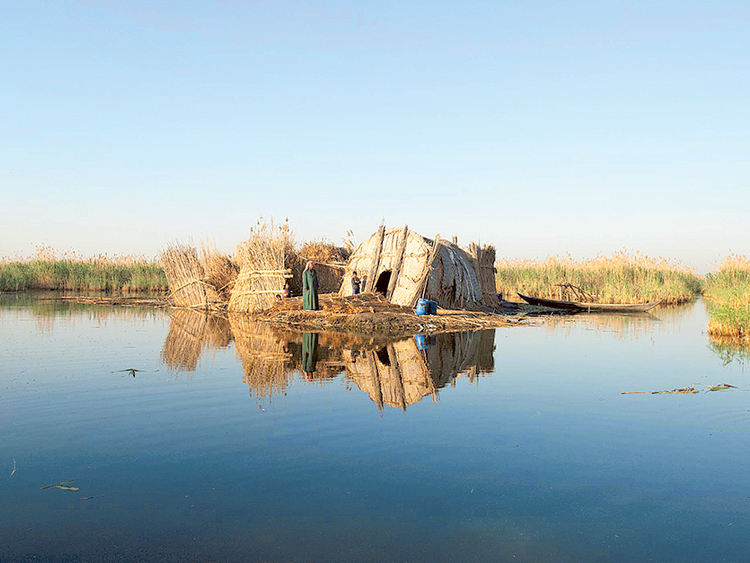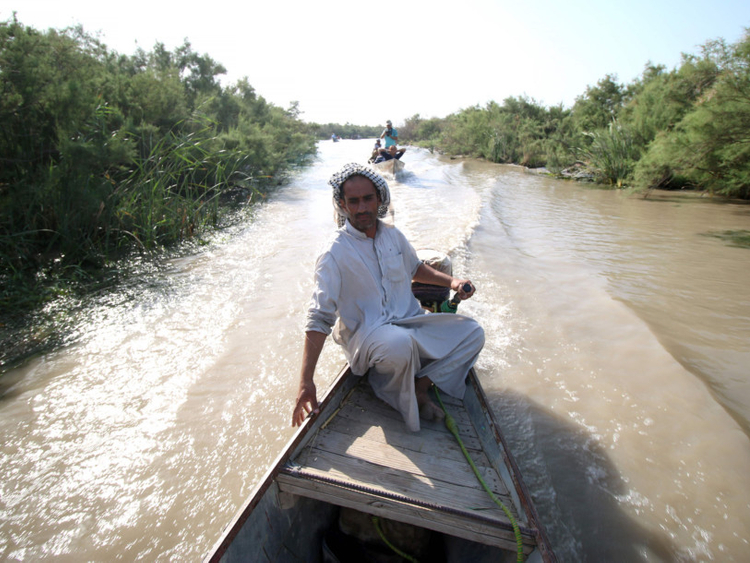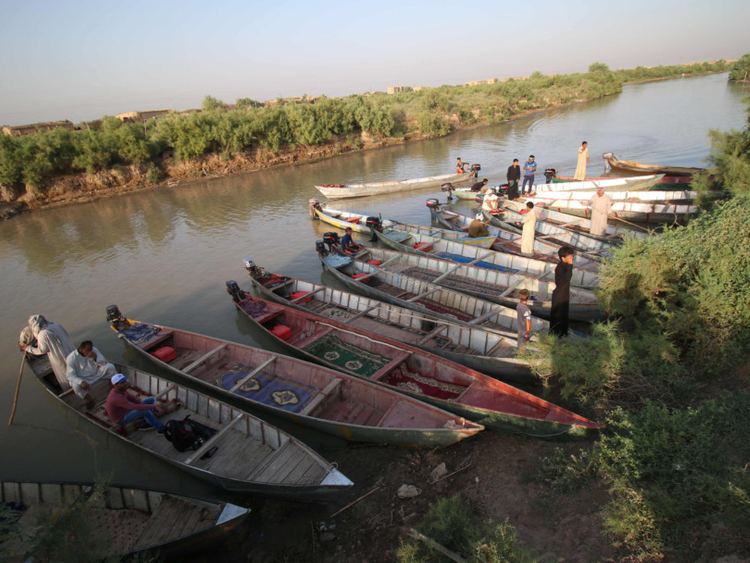
Propelled by outboard engines, our long sleek aluminium canoes bounce across a sheet of choppy water so broad that we can see no land. We are drenched by the spray, but what worries me more is that we’re heading directly towards Iraq’s unmarked border with Iran and I have no wish to be arrested as a British spy. In time, however, a sanctuary appears in the form of a long black line on the horizon. It is a vast reed bed. Soon we are nosing along narrow channels flanked by impenetrable forests of brown-stalked, green-leafed, tassel-headed reeds 20-feet high.
How our elderly, toothless and leather-faced Iraqi boatman, Taresh Jasim, finds his way through this watery labyrinth I have no idea, but eventually we reach a platform fashioned from mud and reed where we disembark. Jasim and his friend, Kadim Jabbar, both dressed in long grey dishdashas with chequered keffiyehs on their heads, cut bundles of reeds to make fires. They cook several large carp and rounds of flatbread. They lay out cucumbers, onions, lemons and tomatoes on a carpet. When the fish is ready we sit cross-legged and eat with our hands, while Jabbar warbles a traditional Iraqi song.
Why am I here? I am attempting to follow in the footsteps — or wake, perhaps — of Wilfred Thesiger, the British explorer who spent seven years living in Iraq’s southern marshes, supposedly the site of the biblical Garden of Eden and Great Flood, in the 1950s. I have come to see what’s left of the 6,000 square miles of Mesopotamian wetlands, fed by the Tigris and Euphrates rivers, where the ancient Sumerians developed writing and agriculture in the so-called cradle of civilisation. I want to know what’s happened to the Marsh Arabs, descendants of those Sumerians, who have lived here for 5,000 unbroken years — fishing, raising water buffalo and growing rice.
Thesiger stayed in mudhifs, the great arched meeting houses built entirely of reeds that belonged to the marsh dwellers’ tribal chiefs. He travelled in taradas, the elegant high-prowed wooden canoes of those shaikhs. He shot wildfowl and wild boar, and watched the Marsh Arabs marry and mourn, dance and sing, hunt and feud.
He won over those notoriously untamed, suspicious people by performing circumcisions — more than 6,000 in all. He thereby spared their sons the ghastly infections and mutilations visited on them by itinerant professional circumcisers who used the dried and powdered foreskins of their previous victims to dress the wounds. He gave the naturalist Gavin Maxwell, briefly his travelling companion, an otter cub that Maxwell named Mijbil, took home to Scotland and immortalised in Ring of Bright Water.
In his own 1964 classic The Marsh Arabs, Thesiger observed, “Their way of life, as yet little affected by the outside world, was unique and the Marshes themselves were beautiful. Here, thank God, was no sign of that drab modernity which, in its uniform of second-hand European clothes, was spreading like a blight across the rest of Iraq.”
He wrote lyrically of the marshes as “a world complete in itself”, and of “the stillness of a world that never knew an engine”.
From where I am picnicking, the marshes appear to have survived very well: in every direction reed banks and water stretch far away. But Thesiger would instantly have seen that things were amiss. There are no villages of reed huts built on man-made floating islands. There are no people, boats or water buffalo, and few of the ducks and geese that, in Thesiger’s day, “darkened acres of water”. Not even the carp that we’re eating were caught here. They came from a fish farm.
On the skyline, moreover, I can see the two flaming-orange gas flares of an oil field. Thesiger feared the discovery of oil in southern Iraq in the 1950s would destroy the marshes by luring their inhabitants to Iraq’s suddenly booming cities. He was wrong about that, but right to foresee the marshes’ looming destruction.
Thesiger’s visits were abruptly curtailed by the military coup that deposed Iraq’s King Faisal II in 1958. That was followed a decade later by the Ba’athist revolution that eventually brought Saddam Hussain to power. The marshes became a sanctuary for Saddam’s opponents, for military deserters during his war with Iran in the 1980s, and for thousands of Shiites who rose against him after the 1991 Gulf War.
Saddam responded with characteristic brutality. He set out to destroy the marshes, using a plan devised by the British in the 1950s to convert them to agricultural use. He built dams and levees to stop water reaching them. He dug great channels — the Prosperity River, the Mother of Battles Canal, the Loyalty to the Leader Channel — to drain them. He used troops, artillery and helicopter gunships to raze the villages, burnt the reed beds, poisoned and mined the waters. Most of the 500,000 Marsh Arabs fled to refugee camps in Iran, or to the slums of Iraqi towns and cities. Less than a tenth of the marshes survived what the UN described as one of the world’s greatest environmental disasters.
Then, in 2003, Saddam was himself deposed by the US-led invasion of Iraq. Using dynamite and bare hands, the Marsh Arabs tore down his dams and dykes. The waters poured back over their desiccated, salt-encrusted lands. By the time I first visited in 2008, roughly half the original marshes had been reflooded, and there was real hope that Saddam’s ‘eco-cide’ could be reversed. Alas, that optimism has proved groundless. A proliferation of dams on the Euphrates and Tigris, combined with government indifference, has once more condemned the marshes to seemingly terminal decline.
The Hawizeh marsh where we picnicked is the biggest, healthiest expanse of wetland left, but it had been swollen by unusually heavy rains and will mostly dry up during the summer. Elsewhere, during my week in southern Iraq, I found few marshes still worthy of the name — just miles and miles of barren wasteland punctuated by sorry remnants of what once was: muddy bogs, fetid pools and stagnant channels, most too saline to support life.
Standing on one of Saddam’s old earthen dams, surveying a great alluvial plain that would once have been wetland, I saw only scrubby desert reminiscent of the dried-up Aral Sea. The Prosperity River, once more than 300-feet wide, had shrunk to a narrow channel. The amount of former marshland reclaimed for agriculture is pitiful.
A government official told me 40 per cent of the marshes have been recovered, but that figure appeared to bear no relation to reality. A study published by Canadian scientists in 2010 found the three main marshlands — Hawizeh, Central and Hammar — had fragmented into 10 smaller marshes, most with poor-quality water, and matters have only deteriorated in the six years since.
“The marshes are dying,” declared my guide, Dr Ali Muthanna, regional manager of a charity called AMAR that provides health and education to displaced Marsh Arabs. “The marshes have almost vanished,” said Baroness Nicholson of Winterbourne, the British peer and former MP who founded AMAR after making the first of many visits to the area in 1991. Iraq’s ambassador to the UN had denied her claim that Saddam was draining the marshes, so she persuaded the Iranian military to smuggle her across the border, armed with a Kalashnikov and dressed as a Marsh Arab, to see for herself. On the remnants of the marshes I found little sign of the abundant wildlife and millions of migratory birds they once harboured, and only a few sad traces of the ancient way of life they used to support.
The marshes once provided 60 per cent of Iraq’s fish, for example, but today supply practically none. Near the town of Al Mijar, one afternoon I found Hilu Mohammad Sabah, barefoot and wearing old Chelsea FC shorts, sifting through a pathetic pile of tiny fish, none more than 3-in long, that he had caught that morning by electrocuting a nearby channel of slimy green water. In his youth, he said, he and a companion would catch more than 90 kg of fish a night, most weighing a few kilos each. “In the old days I was a rich man. Now I’m a poor man,” he lamented.
In Thesiger’s day the town of Al Huwair was right on the edge of the Central marshes and was the area’s boatbuilding capital — “Everyone seemed to be directly or indirectly concerned with building boats,” he wrote. Today it is 20 miles from the nearest water and has just two boatbuilders left — Asi Salim Obeid, 50, and his cousin, Akil Amair, 25.
The sons and grandsons of boatbuilders, they construct mashuf — traditional wooden canoes with tarred hulls — in breeze-block sheds with corrugated iron roofs. They shape the parts and nail them together with astonishing dexterity, and in exactly the manner described by Thesiger. They can each build a boat a day, but Obeid has four unsold canoes in his workshop and Amair has seven lining the alley outside his. As for the much grander, scimitar-shaped taradas used by the shaikhs, Obeid last built one in the 1980s and Amair never. “Everything is collapsing. The demand for boats is less and less,” Obeid complained. “I will be the last to make them,” Amair added sadly.
The shaikhs still build mudhifs for entertaining visitors or holding tribal meetings, and I was twice received as an “honoured guest”. Those astonishing constructions consist of reed matting laid over a line of perhaps nine, 11 or 13 arches fashioned from reed bundles as thick as a human torso (the number of arches is always odd, and the entrances always face Makkah). Thesiger called these mudhifs “an extraordinary architectural achievement with the simplest possible materials”, and likened their cool, dark interiors to Christian cathedrals.
But humbler reed houses have become increasingly rare — the abodes of those too poor to afford more permanent homes, or of seasonal workers like the cattle herders I found living beside a stretch of water next to the road to Chibayish. They still harvest hashish — young green reeds — as fodder for their cows and water buffalo, piling it so high on their canoes that the craft themselves cannot be seen. But they told me their animals could no longer drink the water because it was too salty. Nowadays they have to buy fresh water from tankers, paying between $3 (Dh11) and $5 for a thousand litres. “Saddam destroyed our lives,” one old-timer complained.
Saddam was certainly the principal villain, but not the only one. It is the extensive damming of the Tigris and Euphrates rivers by Turkey, Iraq and Syria that has prevented the marshes’ recovering from his depredations, staunching the water that is their lifeblood. The Canadian study found these countries had built no fewer than 36 dams on those rivers and their tributaries, with another 21 planned or under construction, for their agriculture, industry and urban centres. Iran compounded the problem in 2009 by building, ostensibly for security reasons, a huge dyke along its border with Iraq that blocks other rivers feeding the Hawizeh marsh. Even Daesh (the self-proclaimed Islamic State of Iraq and the Levant) has contributed, reportedly withholding water behind dams it seized in Mosul and Ramadi.
The damming not only means too little water reaches the marshes. It also stops the spring surges, caused by melting snow in the Turkish mountains, that were so essential for replenishing the wetlands and flushing away contaminants like salt before the fish began to spawn. Distracted by continuing conflicts and a financial crisis caused by falling oil prices, Baghdad has done little to remedy the situation. “The government has given up on the marshes totally,” Dr Muthanna complained.
“By doing nothing they have perpetuated what Saddam did,” Baroness Nicholson added.
“We feel betrayed by the government,” said Sahid Mahdi Dahir, a tribal shaikh, resplendent in headdress and flowing robes, whom I met in Basra.
In 2013 the Iraqi Council of Ministers approved the creation of Iraq’s first national park on 385 square miles of the Central marshes, but there is no sign of it on the ground. “It should be set up by Baghdad but they haven’t done it,” said Sumaiya Ahmad Najam, a senior official at the Ministry of Water Resources’ Marshlands Revival Centre. She added that the Centre had received no funding since 2014, and that the oil ministry actually supported the drainage of some marshes to facilitate exploration.
In the meantime the former marsh dwellers lead generally wretched lives. Some live near the edges of the much-diminished marshes in sad, litter-strewn settlements of mud or breezeblock houses — places like Abu Kassam, from which we set off for our picnic. There is little work or sense of purpose, and services are scant. “The old way of life is finished. It’s impossible to get it back,” said Jasim, our boatman. “We were waiting and hoping for real changes in our lives after Saddam but the new politicians who came after him have done nothing.”
Most have moved to urban centres. There they have proper shelter, electricity and sanitation, but they are spurned and disparaged by other Iraqis. Few are educated. Most are unemployed, or work as menial labourers. They have a reputation for feuding and fighting, stealing and smuggling. Baroness Nicholson calls them ‘lost souls’ who “have been hauled into the modern world but not been given the tools with which to manage their lives.”
In truth, life on the marshes was extraordinarily tough, as Thesiger made clear. He described at length the blood feuds and honour killings, the regular gorings by wild boar, the thieving, dirt, mosquitos, fleas and rampant disease. Gavin Maxwell memorably described Thesiger’s makeshift surgeries in the marshes as “a kaleidoscope of cataracted eyes, suppurating boil craters, patches of angry rashes on brown skin, wounds and swollen genitals.”
But it is a measure of their present condition that most displaced marsh dwellers feel only nostalgia for their former existence. “Life was much better in the marshes. It was virgin nature, a sort of paradise,” said Abdulkarim Fadhil, 45, who lives in a colony of small breeze-block houses built on barren mudflats outside Basra that are littered with rusting fridges, plastic bottles and other rubbish. “We long to go back to the marshes, but the last time we went they were just like deserts,” said a neighbour, Basam Abdulimam, who produced — like some sort of talisman — a faded and well-thumbed colour photo of himself standing by a canoe with his father and brothers a quarter of a century ago.
On my final afternoon I visited a great silver-domed memorial for the many thousands of Marsh Arabs killed by Saddam that stands on former marshland near Chibayish and is visible for miles around. Inside, blown-up photographs show the exhumations of mass-burial sites, weeping relatives discovering the remains of loved ones, mutilated and decomposing bodies, cracked and blindfolded skulls.
Saddam’s attempt to exterminate the Marsh Arabs was tantamount to genocide, but he was guilty of much more than that. He destroyed a unique and precious culture that had survived for five millennia, and a habitat that was one of the great natural wonders of the world. All that survives is Thesiger’s exquisite prose: “Memories of that first visit to the Marshes have never left me: firelight on a half-turned face, the crying of geese, duck flighting in to feed, a boy’s voice singing somewhere in the dark, canoes moving in procession down a waterway, the setting sun seen crimson through the smoke of burning reed beds.”
–The Telegraph Group Limited, London 2016
For more details on the London-based AMAR foundation, see amarfoundation.org
















